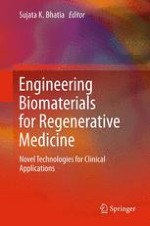2012 | OriginalPaper | Chapter
3. Oxygen Supply for Tissue Engineering
Authors : Whitney L. Stoppel, Susan C. Roberts
Published in: Engineering Biomaterials for Regenerative Medicine
Publisher: Springer New York
Activate our intelligent search to find suitable subject content or patents.
Select sections of text to find matching patents with Artificial Intelligence. powered by
Select sections of text to find additional relevant content using AI-assisted search. powered by
